Related Content
Content
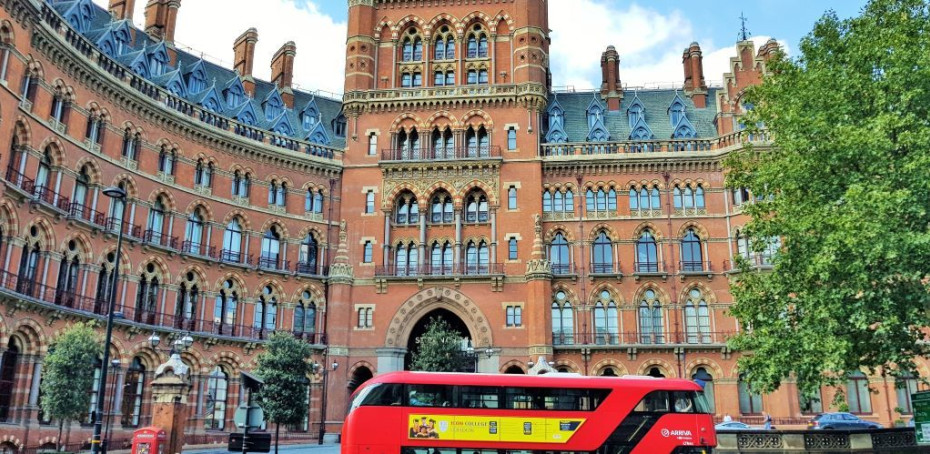
How to travel between St Pancras International and other London stations
Tips for making the easiest possible transfers across the city centre when travelling between St Pancras International and the other major stations in central London.
Share
The guides below on how to travel between St Pancras International and the other London stations are focused on, or at least include, the easiest routes, so that the simpler alternatives when travelling with heavy luggage or with young children etc can be followed.
At weekends the Underground lines and both the Elizabeth line and Thameslink trains can be impacted by construction work, those affecting the Underground and Elizabeth line trains can be looked up here, while those impacting the Thameslink trains, can be found here.
Good to know:
Three different train services provide the links between St Pancras International and the other main stations in central London:
- The trains which arrive at and depart from St Pancras Thameslink station, which now also connect with the Elizabeth line trains at Farringdon.
When arriving at St Pancras by Eurostar, you can find the Thameslink station by turning right when you pass into the station through the exit door from Arrivals -And then having walked to the far end of the main atrium in the station, you will see the entrance to the Thameslink station over to the left.
The Thameslink station is immediately below the part of the station that the EMR trains will arrive at.
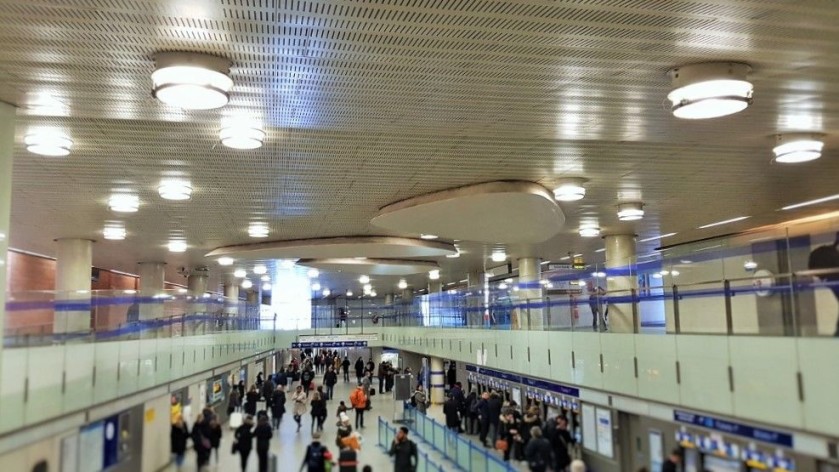
- Directly in front of the main station building is the Underground ticket hall, pictured above, which is above the 'sub-surface' lines - the Circle, Hammersmith and City and the Metropolitan lines. They all share the same set of platforms (tracks), which can be accessed by a lift (elevator) as well as a short flight of stairs.
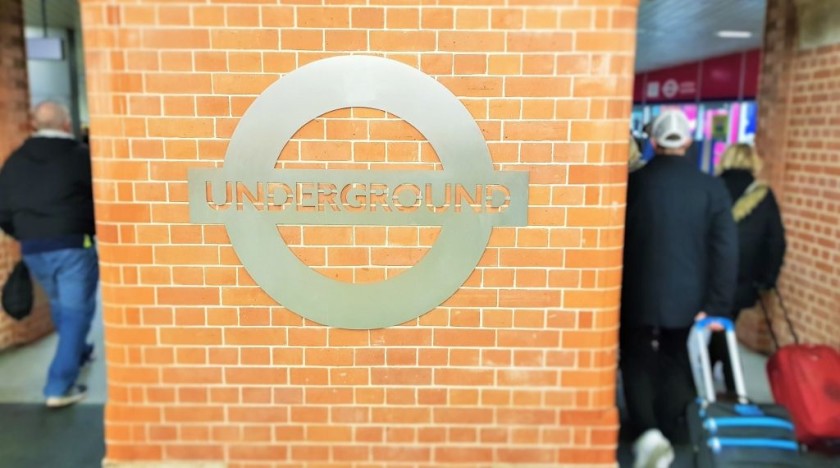
Turn left when when you pass into the station through the exit door from Eurostar Arrivals and then at the end of the atrium walk through the arched doors (pictured above) and turn to the left - you will see a Transport For London Visitor Centre over to the right.
Though when arriving by EMR, Southeastern and Thameslink trains, this ticket hall is some distance away, it's at the opposite end of the long atrium - which is to the right of and below the Eurostar platforms.
- The tube lines which serve St Pancras International are the Northern, Piccadilly and Victoria lines and they can be accessed from two different areas of the main station building:
(1) On the other side of the ticket hall, which serves the sub-surface lines, is another less obvious ticket hall which houses escalators down to the tube lines.
It can be accessed by turning left from Eurostar arrivals and then crossing through to the other side of the first part of the Underground station that you will come to.
When arriving by Eurostar this is a much quicker route to the Northern, Piccadilly and Victoria lines.

(2) At the end of the station to the left of the exit from the Thameslink station and below the area of the station that the Southeastern trains arrive at, is the access pictured above, to a passage way to an alternative Underground ticket hall - But this ticket hall is under King's Cross station, which is across the street.
So the passage way is fairly long, as are the passage ways which lead to the Piccadilly and Victoria lines from this ticket hall.
Though if you would rather use lifts (elevators) instead of escalators to access these tube lines, then this is the route to take.
If you arrive at St Pancras by the EMR, Southeastern and Thameslink trains and will be travelling on by the Northern and Piccadilly lines, the quicker route is to access the other ticket hall described above
A Summary of how the ticketing works
All of the ticket gates at central London stations have 'readers' which enable contactless payment.
Regardless of whether you are resident in the UK, or are visiting, there are three methods of using Contactless:
- A payment app on a mobile device, including your bank's contactless payment app, or the likes of Google Pay, Apple Pay, or Samsung Pay.
- A debit / credit card as long as it has the contactless symbol
- An Oyster card (you touch in and out as you do when using Contactless).
Good to know about using Contactless
- The system works by touching in and out.
- When using bank cards, take care to use the same card when touching out at the end of a journey, as you did when touching in at the start.
- You have to pay with Contactless on the regular red buses, you cannot pay with cash.
- When travelling by the Underground or Elizabeth line, you can save 10 - 20p per journey by paying with a banking app / card instead of an Oyster card.
- Making a Contactless payment is cheaper than buying a ticket from a station counter or machine - the price difference is usually at least 50%!
More info is available on the general London by train guide.
From St Panrcas International:
Note the advice for travel to a station from St Pancras International can vary from that on how to access St Pancras from another station, for multiple reasons including the availability of lifts (elevators) in various locations and the access to and from bus stops.
to Euston
Taking the Underground one stop to Euston from St Pancras International can seem an un-necessary expense, and a hassle.
However, if you have luggage, it can be a better option than making the 10-12 min walk.
If you're going to opt for the Underground when arriving by Eurostar, turn left from Eurostar arrivals and head towards a northbound Northern line train.
A plus of taking the Underground is Euston station is further down Euston Road than it looks on a map, and working out how to enter Euston station from the street is a challenge.
In contrast the exit from the Underground station at Euston takes you direct into that station's main departure hall.
If you do opt to walk, heading to Euston station from St Pancras International will take around 8 - 15 minutes.
if you arrive at St Pancras on an East Midlands, Southeastern or Thameslink service, head for the exit on to Midland Road; it's by the access to the Thameslink part of the station, at the opposite end of the 'Market' area of the station to the access to King's Cross station.
When you step outside the station, the Francis Crick Institute building will be across the street.
Or if you arrive by Eurostar follow the signs to the taxi rank as it is located on Midland Road, when you step out of the station turn to the left.
- From either of these exits turn to the left and walk down Midland Road keeping the station building on your left.
- At the end of Midland Road you will reach the junction with Euston Road, turn to the right and cross the street and head towards the British Library, which you will now see on the right.
- Three blocks over, you will pass the Unison Building, with the word 'Unison' in large letters mounted on the pavement.
- From here turn right and left, on two short streets used by the buses which serve Euston's bus station.
- The access to the the railway station will then be up the short flight of steps you'll see ahead across the street; a longer step-free route into the station is also available.
Though if you will be arriving on a Eurostar and heading to Manchester, you can avoid having to make this transfer by taking a train from King's Cross to Leeds.
King's Cross is just across the street from Eurostar arrivals - and Leeds typically has four or five trains per hour to Manchester.
Similarly if you will be heading to Glasgow there is a daily direct train from King's Cross to Glasgow, or if that doesn't suit you can take a train from King's Cross to Edinburgh, to connect there for a train on to Glasgow.
to Liverpool Street
Take any eastbound train on the Circle, Hammersmith & City and Metropolitan lines, they all leave from the same platform.
The trains will then arrive at Liverpool Street on the patform adjacent to its Underground station's ticket hall.
To the right of the steps which lead up to the main concourse, an elevator is also available, all onward departures can be accessed from the main concourse.
to London Bridge
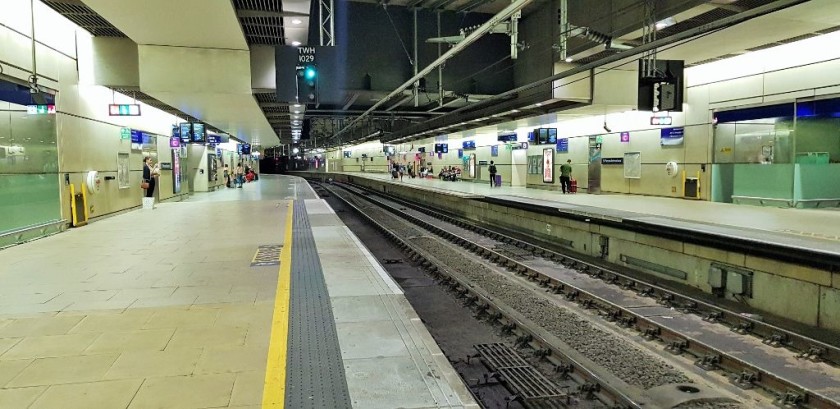
Lifts (elevators) and relatively short escalators are available down to platform/track A used by the southbound Thameslink trains.
Up to 12 trains per hour now take just over 15 minutes to travel from St Pancras to London Bridge station, though note the trains heading towards Sutton from St Pancras don't go to London Bridge.
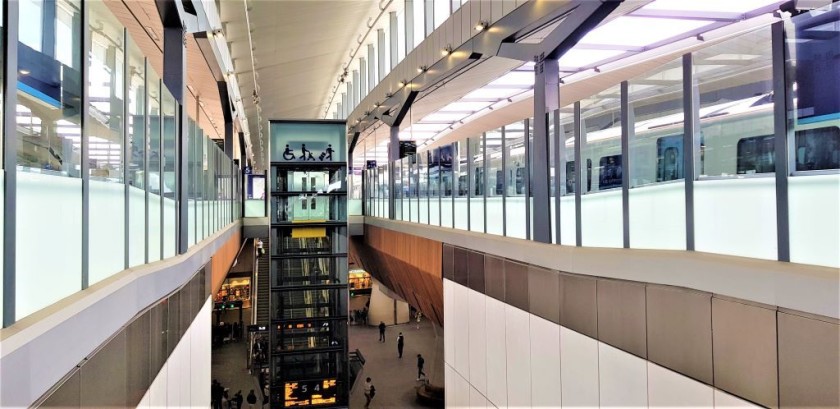
At London Bridge a lift (elevator) and escalators link the Thameslink trains to the main concourse, from where step-free access by other lifts and escalators is available to all of the other platforms/tracks in the station.
Though the Thameslink trains typically head on beyond London Bridge to multiple locations including Brighton, Gatwick Airport and Rainham via Greenwich and Woolwich.
All trains from Cannon Street and Charing Cross stations now call at London Bridge, so there is no need to make the comparatively awkward transfers to either of those stations from St Pancras.
So you can avoid having to make fairly lengthy transfers from and to the Northern line trains at both St Pancras and London Bridge stations, plus the Thameslink trains will be air-conditioned and they have luggage racks.
Though when the Thameslink trains aren't available due to construction work, the Northern line of the Underground provides an alternative.
to Paddington
If you don't have heavy luggage:
Head to the the part of the Underground station at St Pancras used by both the Circle and Hammersmith & City lines - as described towards the top of the page
Take an eastbound train to Paddington; these trains will be heading to Hammersmith.
These Underground lines can be accessed by lift (elevator), but if you arrive at St Pancras by the EMR or Southeastern trains, the access to them is at the opposite end of the station.
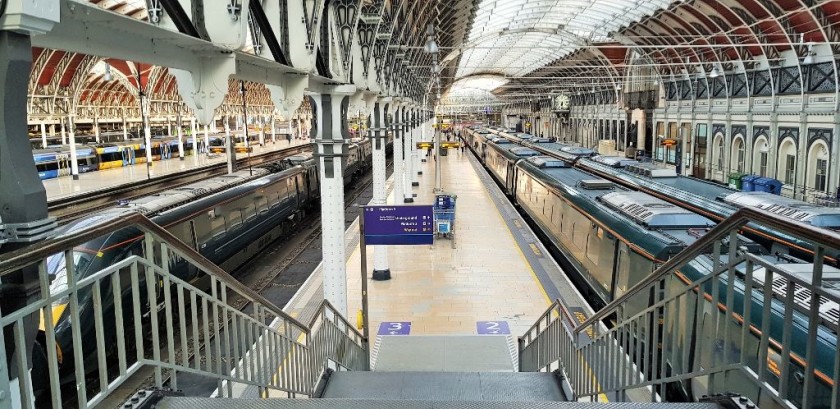
Though at Paddington, the Underground station used by these lines, is some distance from the main concourse, where most of the station facilities at Paddington are located.
Also the short-cut route from Circle and Hammersmith & City lines to all of the main line departures from Paddington, involves walking down staircases, one of which is pictured above.
If you do have heavy luggage
This route involves a transfer, but the step-free access to and from the trains is shorter at both St Pancras and Paddington, in comparison to the transfer from and to the Circle and Hammersmith & City line trains
When arriving at St Pancras by Eurostar, you can find the Thameslink station by turning right when you pass into the station through the exit door from Arrivals -And then having walked to the far end of the main atrium in the station, you will see the entrance to the Thameslink station over to the left.
The Thameslink station is immediately below the part of the station that the EMR trains will arrive at.
Elevators and relatively short escalators are available down to the platform/track used by the southbound Thameslink trains, which is platform A.
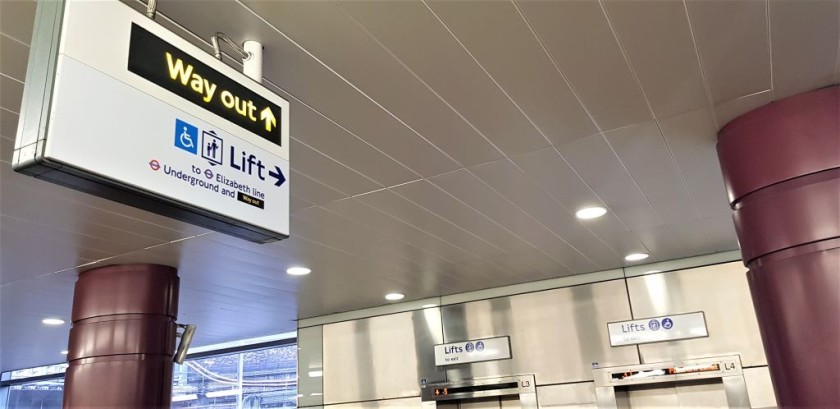
Up to 16 trains per hour now depart from platform A for a one station hop to Farringdon and at that station, on the southbound platform, there is lift / elevator down to the Elizabeth line, pictured above, which is by the front of the trains.
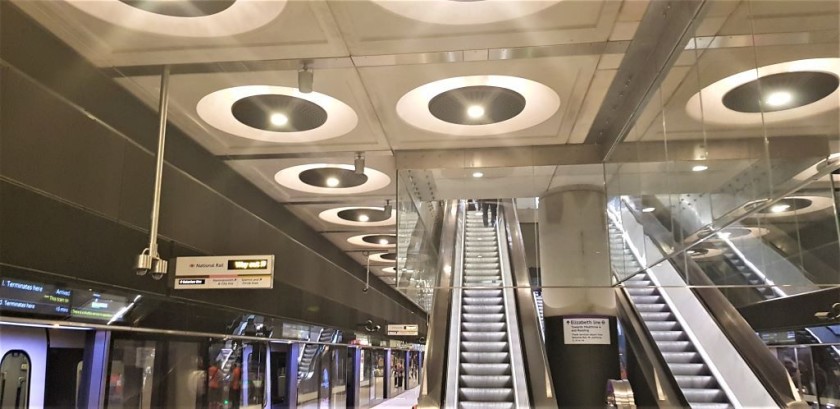
All westbound Elizabeth line trains will go to Paddington where the Elizabeth line is adjacent to the main concourse and both lifts and escalators (picture above) are available up to the main station.
to Victoria
Taking the Victoria line of the Underground is the fastest option, but its permanently crowded and the transfer at St Pancras involves walking along seemingly never-ending subways.
Also bus line 390 doesn't provide a particularly convenient alternative in this direction, as the stop at St Pancras is awkwardly located on the other side of Euston Road
So easier option for accessing Victoria station from St Pancras, particularly if you have heavy luggage, is this route:

(1) Lifts (elevators) and relatively short escalators are available down to the platform/track used by the southbound Thameslink trains, which is platform A (pictured above)
Up to 16 trains per hour now depart from platform A for Blackfriars; the ride takes less than 10 minutes.
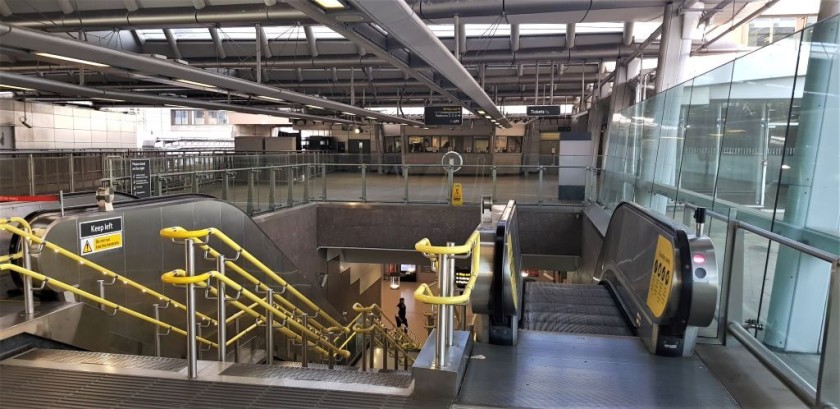
(2) At Blackfriars station elevators and escalators, pictured above, provide provide step-free connections to the westbound Circle and District Line.
All of those trains will go to Victoria; though when you're on the Thameslink platform in St Pancras; Board into the rear of the trains, as this will enable a quicker transfer at Blackfriars.
(3) The Circle and District lines aren't deep-level 'tube' lines, so at Victoria the exit from them is by using a fairly short staircase and a lift is also available.
However, if you will be heading to a destination south of East Croydon, the easier option is to take a Thameslink train to that station from St Pancras and then make a step-free transfer at East Croydon station.
to Waterloo
There isn't a direct Underground Line to Waterloo from St Pancras
Of the many options, SMTJ's preference is to take the Piccadilly Line southbound to Leicester Square and connect there into the southbound Northern line, as the connection between the two lines at Leicester Square involves a comparatively short set of stairs.
Though at Piccadilly Circus station an escalator link is available to the southbound Bakerloo line, which also goes to Waterloo.
Or if you'll have heavy luggage etc, the less obvious route from St Pancras to Waterloo, which avoids escalators is:
- Take one of the 12 trains an hour from platform A in St Pancras Thameslink station, which will be heading to London Bridge.
- At London Bridge station lifts (elevators) and escalators will enable easy access to platforms 8 and 9, from where all the trains will call at Waterloo (East); Trains depart at least every 5 minutes.
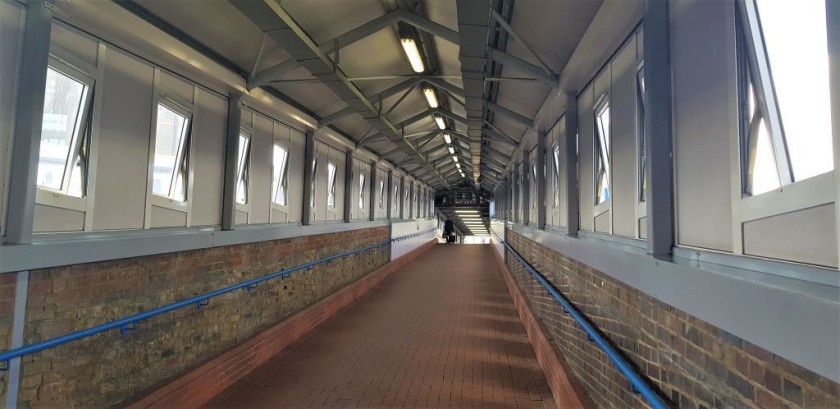
- Waterloo (East) station is adjacent to the main station at Waterloo, to which it has step-free access by a footbridge, though a fairly step slope, pictured above, leads up to it from the trains.
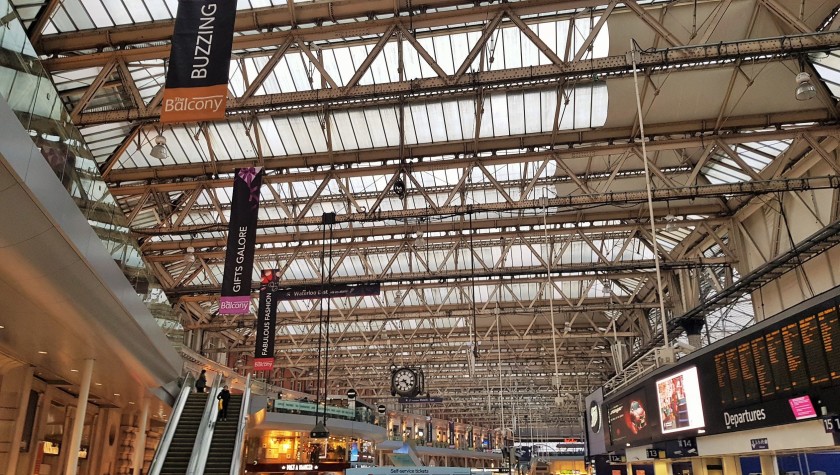
At the other end of the footbridge a lift (elevator) and escalators are available down to the main concourse.
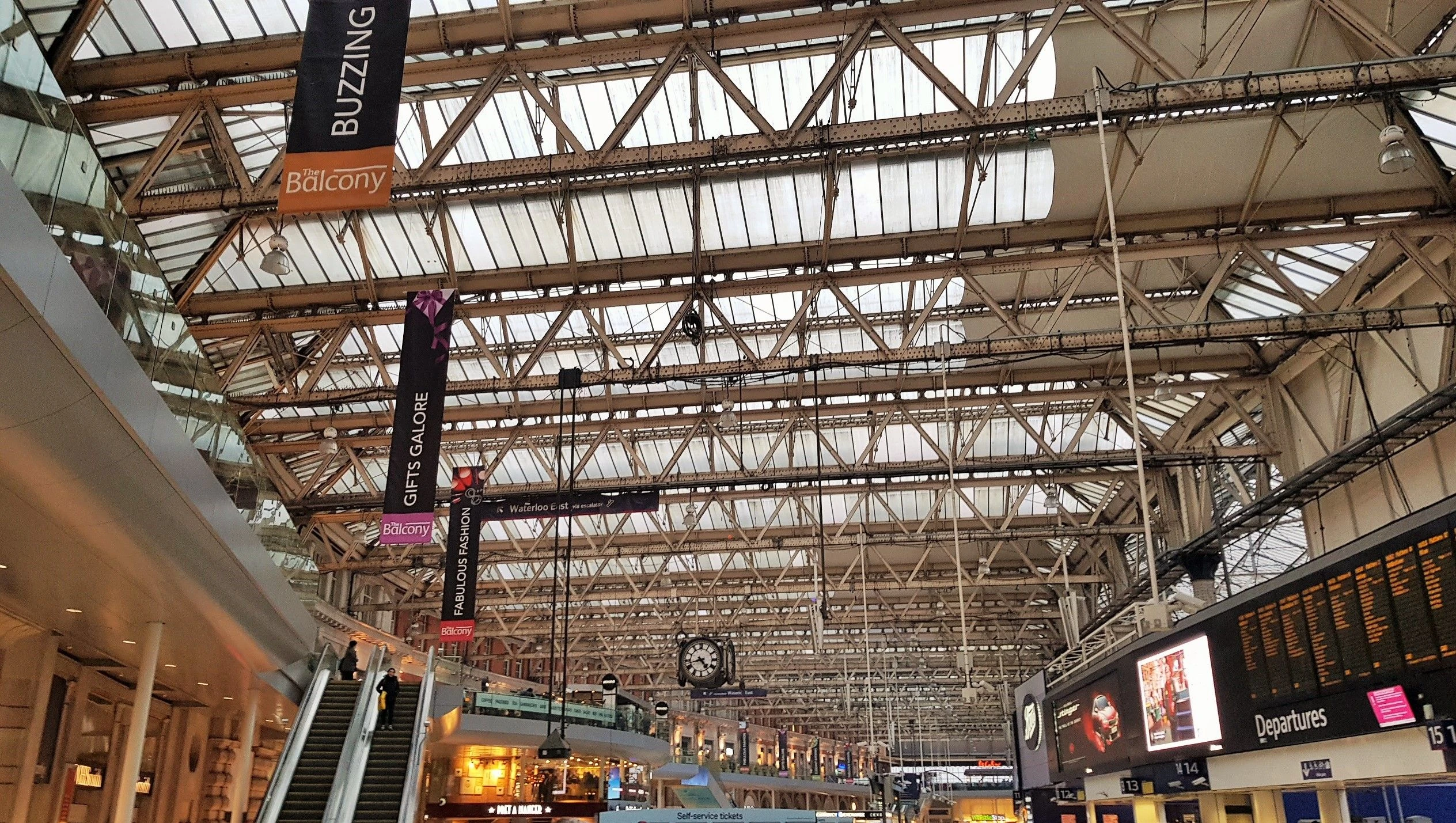
To St Pancras International:
Multiple bus stops are located right by St Pancras International, so the access between them and the station avoids having to cross busy roads.
Hence taking the bus can often be a good option for station to station transfer to St Pancras.
Bus travel has been transformed for the better in central London in other ways; access on to the buses has become easier, they have luggage storage and also have on-board info, both audio and visual, which informs passengers of the stop they’re about to arrive at.
Plus asking the driver where you need to leave the bus is of course still an option.
Taking the bus is also cheaper than taking the Underground, the bus fare is £1.50, but a Zone 1 journey by Underground is £2.80 when using Contactless payment; The end-to-end tickets for train journeys which involve a cross-London transfer won't include the bus ride, but they can be used on the Underground.
You can’t pay for a bus ride with cash, so have to use Contactless payment or Oyster Cards - which can’t be purchased from the driver, but can be issued by machines in the Underground station.
from Euston
A one-stop hop on the Underground is a comparatively expensive means of heading to St Pancras if you’re willing to pay the tube fare, you may as well take a taxi.
If you do take the Underground, a southbound Northern line train via Bank is a better option than taking the northbound Victoria line.
This is because the transfer from the Northern line to the mainline trains in King’s Cross, St Pancras underground station is easier than from the Victoria line; though if possible board the towards the front of the train.
Or take the bus; from bus stop C in the bus station in front of the rail station, it’s a two stop ride on bus routes 91 and 390 to St Pancras.
Or walk as it will only take 12-20 minutes:
- Head to the left hand side of the station concourse and then access Euston Road, which is the main street in front of the station, it's on the other side of the bus station and a small green area.
- When you reach Euston Road turn to the left and four blocks over you will see the entrance to The British Library on the left.
- Take the next street on the left, which is named Midland Road.
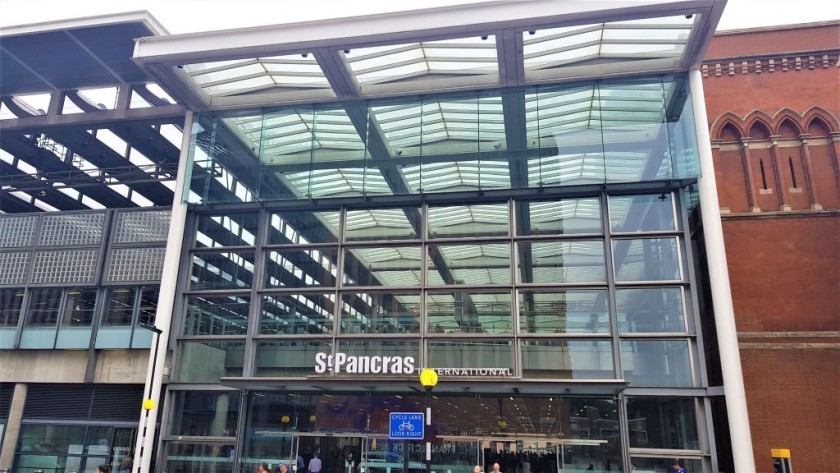
St Pancras station is on the right-hand side of the street, you'll soon come to the entrance on Midland Road pictured above.
Once you're in the station, go right for Eurostar arrivals and departures, up a level for the East Midlands and Southeastern trains, and the entrance to the Thameslink part of the station will be over to the left.
Though the transfer to St Pancras International is infinitely easier from King's Cross station than it is from from Euston, so if you'll be connecting into a Eurostar and your journey will be commencing in Manchester, you can have a step-free end-to-end trip if you travel via Leeds.
Similarly if you will be heading to Eurostar departures from Glasgow, the easier option is to travel via Edinburgh.
Also if you’re thinking of heading to St Pancras in order to take a Thameslink train heading south towards Brighton or Gatwick Airport, take the Northern line to London Bridge instead and make the transfer there, as this route will be much easier; and is all undercover, if the weather is poor.
from Liverpool Street
Taking the westbound Circle, Hammersmith and City or Metropolitan lines can seem the logical, direct option, but the access to the westbound lines at Liverpool Street involves going up and over a footbridge that's somewhat hidden within the Underground station.
So the much easier route if you have luggage etc is
- Taking a westbound Elizabeth line train to Farringdon.
- Connecting there for northbound Thameslink train to St Pancras International, a lift (elevator) is available.
- Use the lifts or escalators to exit the Thameslink station
The access to the Elizabeth line at Liverpool Street is on the other side of the main Underground ticket hall, which is opposite platforms 3 - 7.
There is a lift available down into this ticket hall to the left of the short flight of stairs.
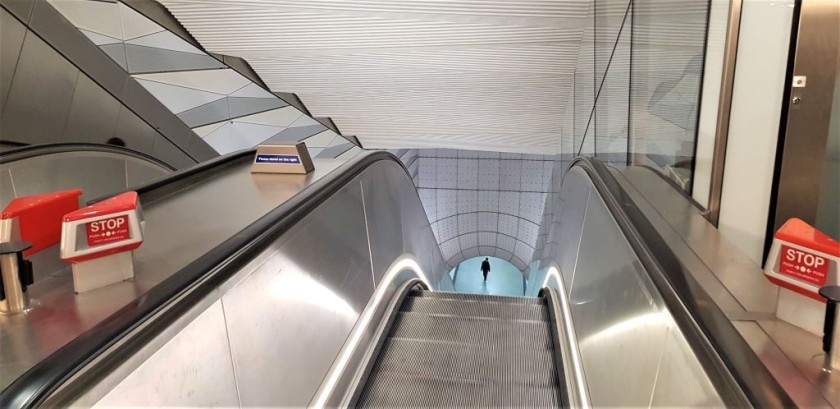
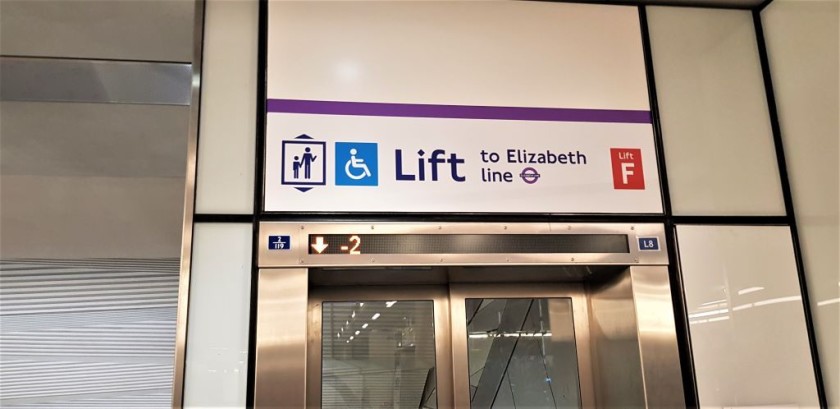
Another escalator and lift (elevator) lead down to the Elizabeth line trains.
from London Bridge
Up to twelve Thameslink trains per hour now depart from platform 5 at London Bridge and take 15-20 mins to make the journey to St Pancras Thameslink.
The departure areas for the EMR and Southeastern trains are immediately above the exit from the Thameslink station, and the check-in for Eurostar departures is less than a minute's walk; Go straight ahead and then over to the left.
So you can avoid having to make fairly lengthy transfers to/from the Northern line at both mainline stations; plus the Thameslink trains will be air-conditioned and they have luggage racks.
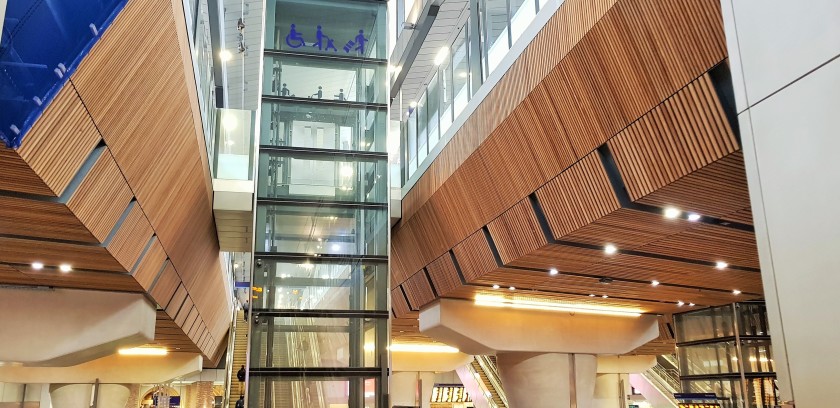
Step free access by lift (elevator), to and from the Thameslink trains, is also available at both London Bridge, pictured above, and St Pancras.
If the Thameslink trains are unavailable or not operating to their usual timetable, the northbound Northern line trains provide an alternative.
from Paddington
If you don't have luggage
The easiest connection from Paddington to St Pancras station, is to take the direct link provided by the Circle and Hammersmith & City lines of the Underground.

If you do have luggage
A new step-free route to King's Cross and St Pancras from Paddington has been provided, the first stage of which involves taking an eastbound Elizabeth line train to Farringdon.
In Farringdon station the escalator provides a direct link from the Elizabeth line to the northbound Thameslink trains for a one-stop hop on to St Pancras; Or you take a combination of two lifts from the Elizabeth line to the northbound Thameslink platform
from Victoria

St Pancras is linked from Victoria station by the northbound Victoria line, but if time is on your side, you can avoid travelling on some of London’s most crowded Underground trains, by taking the bus instead.
Bus line/route 390 leaves from stop C in the bus bays right in front of the rail station.
It then stops on the same block as St Pancras station.
from Waterloo
A quick glance at the Underground map reveals the lack of a direct link from Waterloo to the Underground station named King's Cross, St Pancras.
Of the multiple options with connections, SMTJ's preference is to take a northbound Bakerloo line and connect at Piccadilly Circus into a northbound Piccadilly line train.
Two reasons; (1) seats and space for luggage will likely be available on the Bakerloo line train, as it will have made only two prior station calls, (2) plus an escalator link is available between the two lines at Piccadilly Circus.
There isn't a direct bus route/line to provide an alternative to taking the Underground, but there is a route available from Waterloo to St Pancras, which also avoids having to use any esclalators.

- Waterloo East station is linked to the main station by a footbridge that can be accessed from the main concourse by escalators and a lift (elevator), then in Waterloo East station slopes, pictured above, lead down to the trains.
- All trains which depart from platforms/tracks A and C in Waterloo East will call at London Bridge, there is a departure indicator which will tell you whether the next train will be leaving from platform A or C; Typically more than fifteen trains per hour will be available.
- At London Bridge lifts/elevators will be available to connect to the main concourse, where steps away, another lift/elevator will take you up to platform 5.
- Twelve trains per hour from platform 5 will usually be making the 15 min journey to St Pancras International station, so the end-to-end journey from Waterloo to St Pancras by this route will typically take 30 - 40 minutes
- On arrival at St Pancras escalators and elevators lead up to the main concourse.

Simon Harper
I wanted to share my passion for train travel and explain how anyone can take the fantastic journeys I have taken.

This is one of more than 100 train travel guides available on ShowMeTheJourney, which will make it easier to take the train journeys you want or need to make. As always, all images were captured on trips taken by ShowMeTheJourney.
This second version of ShowMeTheJourney is exciting and new, so we are genuinely thrilled that you are here and reading this, but we also need your help.
We’re striving not to let anything get in the way of providing the most useful service possible, hence a facility has been set up with DonorBox which can be used to support the running costs and make improvements.
Instead of advertising or paywalls, your financial support will make a positive difference to delivering an enhanced service, as there’s a lot of ideas which we want to make happen.
So if you have found the info provided here to be useful, please consider saying thank you.





